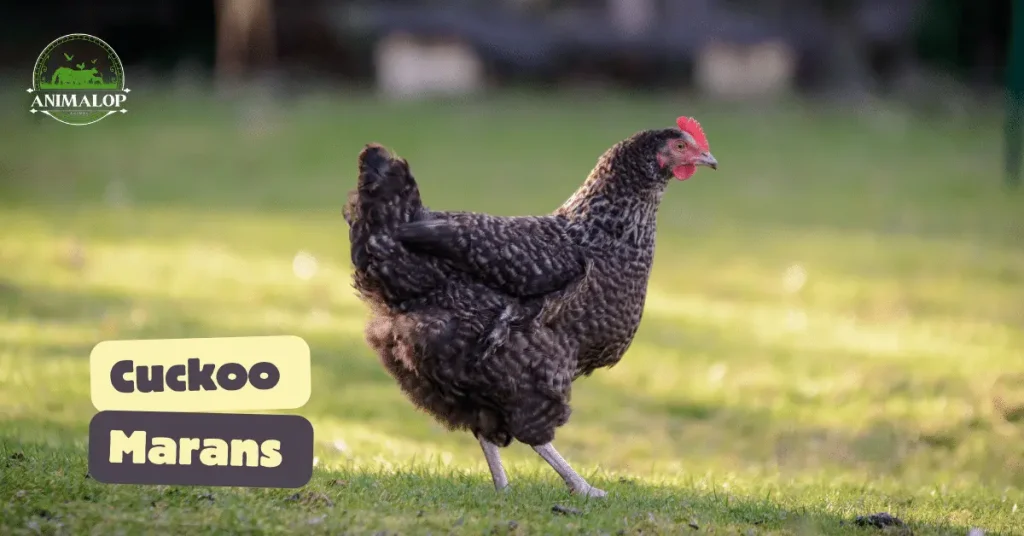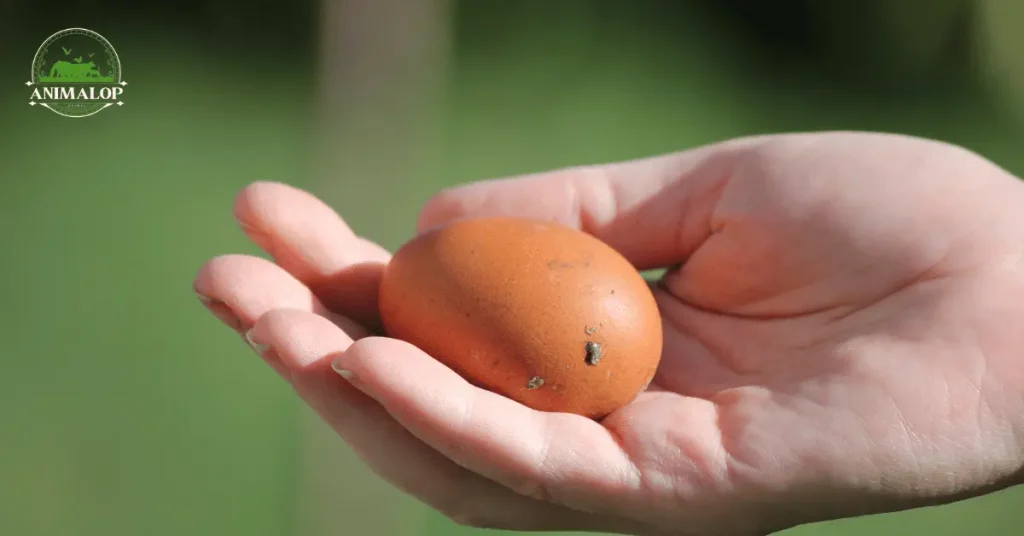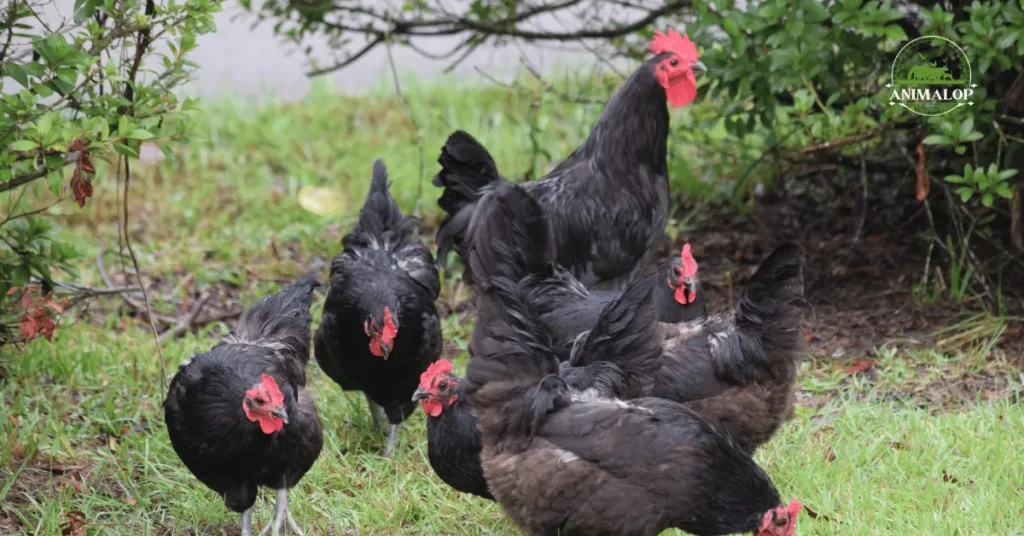Cuckoo Marans Breed: Traits, Temperament, Facts 2024
Do you want to make your backyard more lively with some feathered friends? Have you ever heard of chickens that lay eggs that look like they’re made of chocolate? They’re Cuckoo Marans chickens.
Cuckoo Marans chickens are super friendly and famous for their unique dark brown eggs. They love hanging out in the yard but don’t like to be cuddled. Despite their sociable nature, they’re quite noisy, so they may not suit city living. But if you’ve got space, like we do in rural Vermont, their chatter won’t be much of a problem, making them a fun and interesting addition to your flock. DO YOU KNOW ABOUT Cinnamon Queen Chicken Breed
These charming birds aren’t just about their looks or the unique eggs they lay; there’s a lot more to them. Let’s get into the full breed profile of the Cuckoo Marans in detail!

Cuckoo Marans Breed: Quick Profile Overview
Cuckoo Marans Eggs
Cuckoo Marans chickens start laying eggs a little later than most other chicken breeds, usually when they’re about 6 to 9 months old, instead of the usual 5 to 6 months.
Once they get going, you can expect at least 4 pretty dark brown eggs from them every week. In their first year, with the right food and care, they can give you between 220 to 280 eggs. But remember, as they get older, they’ll lay fewer eggs each year, dropping by about 10 to 15%, until they eventually stop laying eggs.
Cuckoo Marans are pretty special because they lay dark brown eggs, which can really make your egg collection flourish.
The color of the eggs could be like a deep russet brown or dark chocolate, and it could change a little from one chicken to another and between different types of Marans chickens.

Cuckoo Marans Breed Origin And History
Cuckoo Marans chickens have been around for a while, starting to become their own kind of chicken back in the early 1800s. But the story goes even further back, all the way to the 1300s in France. Back then, local farmers started mixing different types of chickens together, like gamecocks and marsh hens. They named these chickens after Marans, a port city in France, because that’s where this mixing mainly happened. These chickens are a mix of a few different breeds, like Croad Langshan’s, Brahmas, and maybe even Faverolles.
Marans are pretty sturdy chickens that are good for providing meat and laying eggs both. They have short, tough feathers and not a lot of fluff. They got really popular in England during the early 1900s because people loved their dark brown eggs. Some of the Cuckoo Marans chickens come with feathers on their toes and legs, but not all of them.
Nowadays, there are quite a few different types of Marans chickens, like the Copper Maran, that are well-known and liked by chicken farmers.
Cuckoo Marans Facts
They’re known as a dual-purpose breed, grown for meat and eggs both.
Lay 180-300 large, dark brown, sometimes patched eggs per year.
Known for being cold hardy with a docile and chatty personality.
Resemble Plymouth Barred Rock with dark and light slate-colored bars; have clean and pinkish-white legs.
Classified as a Heritage Breed.
Cuckoo Marans Appearance
Resembling Plymouth Barred Rocks closely, Cuckoo Marans chickens share dark white lined feathers. However, you can recognize them by their straight combs and darker plumage.
They’re a little bigger than average chickens, with roosters weighing around 7 pounds and hens about 6 pounds.
These chickens have medium-sized wattles, a single bright red comb, and red earlobes. They’ve got bare legs and fluffy feathers that make them look even bigger. The Cuckoo Marans chickens seem to be even bigger than other breeds because they’re cold-tolerant like our Columbian Wyandottes.
Cuckoo Marans chickens can live around 7 years in backyard conditions, which is pretty average for chickens. But if you’re raising them for meat, they may have a shorter lifespan of about 2 to 3 years because they lay fewer eggs as they get older.
Cuckoo Marans Temperament And Characteristics
Cuckoo Marans chickens are usually friendly and gentle but prefer not to be cuddled too much. They’re happier following you around or pecking at snacks in the yard. They live with other birds easily and enjoy foraging in mixed flocks.
These chickens can tolerate both cold and hot weather and are known for laying lots of eggs and providing tasty meat in both climate conditions.
Friendly and easygoing, Cuckoo Marans are happier around kids. Even though they’re not aggressive, these chickens generally end up being the bosses of the chicken coop.
They may not be too welcoming to new chickens and can be protective of their flock.
Besides, Cuckoo Marans chickens are on the louder side, which might not be ideal for urban farms in crowded neighborhoods. In our experience, they make quite a bit of noise, even more than our rooster. So, if you reside in a densely populated region, it’s probably best to go with quieter breeds.

Cuckoo Marans Broodiness
Cuckoo Marans chickens are well-known for getting broody who want to sit on nests. They’re great at taking care of their eggs and chicks all by themselves, without any help from people around them. They are caring mothers.
Cuckoo Marans Care Guide
Caring for Cuckoo Marans is a breeze, thanks to their low-maintenance needs and resilient nature nature. With attention to their diet, living space, and health, these charming chickens make delightful additions to any poultry enthusiast’s backyard.
Health
Cuckoo Marans chickens are quite resistant to diseases. However, they could be sensitive to extreme heat, so you should keep them in a little cool environment, since they have lots of feathers.
To keep them healthy, we make sure they get vitamins in their water, especially for younger birds joining the flock. We also give them oyster shells to munch on, which provides calcium and strengthens their eggshells. So that, they stay healthy and keeps laying strong eggs.
While they’re generally hardy, it’s still necessary to keep an eye out for parasites and illness specifically for the French or US standard varieties to keep your flock happy and healthy.
Space Requirements
Cuckoo Marans are ideal for beginners because they’re very jolly and easy peasy to care for. They can handle being cooped up but do better with more room, about 4 square feet per bird in the coop. Keeping their legs clean with dry sand bedding is important, especially for French varieties.
Do ensure that the coop is safe and draft-free, but you don’t need to heat it. In the outdoor area, give them at least 10 square feet per bird, and provide shade and enough airflow when it’s hot to keep them happy and healthy.
Cuckoo Marans Diet
When you first bring home your chickens, feed them growers mash for about 6 weeks, then switch to chicken pellets until they’re 18 weeks old. After that, give them layers mash or pellets to help with egg production. They need fresh water all day, ideally at beak level to keep it clean. Make sure they always have access to grit to help with egg production.
Marans eat about 5 to 7 ounces of food a day, with breeders typically giving them around 6 ounces. They love foraging for bugs and seeds outside, which adds to their diet.
Avoid feeding them chocolate, beans, or moldy food due to health concerns. It’s also illegal to feed chickens leftovers in the UK (source).

Other Types Of Cuckoo Maran Chickens
| Blue | Marans | White |
| Cuckoo | Cuckoo Marans rooster | Red |
| Black | Leghorn chicken | Wheaten |
| Columbian | Birchen | White Marans |
Cuckoo Maran Hen Vs Rooster
You can differentiate Cuckoo Marans roosters from hens by observing their tail feathers. Roosters have long and curved feathers that gracefully slope downward, while hens lack this characteristic.
Cuckoo Maran Chicken Vs Barred Rock
Cuckoo Marans chickens have dark feathers with white speckles, whereas Barred Rock chickens come with black and white striped feathers. Despite their visual differences, both breeds share the characteristic red combs and wattles.
FAQs
Final Thoughts
In my recommendation, if you want to bring a unique addition to your backyard flock, Cuckoo Marans with their chocolate-colored eggs and friendly nature would be a suitable pick. They’re not only fun to have around but also easy to care for that would definitely make your chicken-keeping experience enjoyable.
